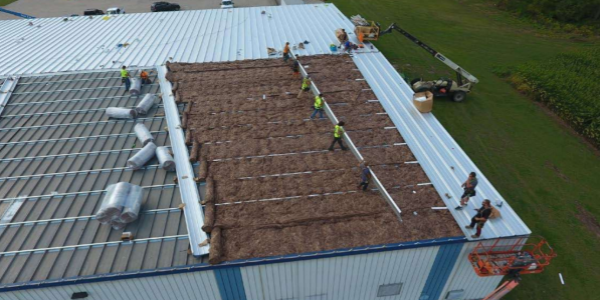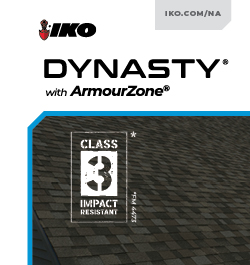To Replace or To Retrofit?

By Dale Nelson, Roof Hugger.
Help your customers choose a proper roof remedy for their metal roof by informing them of the benefits of retrofitting.
The age-old question for metal roof owners: When should I remove and replace my old metal roof with a new one? Answer this customer question with another question: Have you considered retrofitting? An excellent alternative to roof replacement, retrofitting is a fast and easy way to fix an old metal roof without disrupting daily operations. You simply install structural steel, sub-framing, members over the old roof panels into the structure below and attach the new roof to these members. The benefits don’t stop there however, read on to learn more about the factors you should consider and benefits of retrofitting a metal roof.
Upgrade time
A retrofit provides the perfect opportunity to make key improvements to a metal roof. First, customers will have the chance to upgrade an older screw-down or through-fastened metal roof to the newer standing-seam type that’ll have few if any exposed fasteners. This is an option they won’t have if they are to remove the existing roof without making significant structural modifications to the framing.
Retrofitting also creates an airspace between the old and new roof structure which is an opportunity to add insulation for energy efficiency. Sub-framing systems can be designed for different heights to reach greater R-values, enabling a non-conditioned space warehouse or storage building to become a climate-controlled structure. Modern heat absorbing, “phase change” materials are also available to accomplish this same goal with a much smaller airspace.
The airspace between the new and old roof can be used to create a dynamic, convective ventilation system for buildings, commonly called “above sheathing ventilation.” Basically, it takes the heated air beneath the new metal roof and exhausts it through vents at the ridge of the building. The benefit is the roof becomes a radiant barrier that reduces heat transfer through its assembly by as much as 45%. Finally, once the retrofit is complete, customers should consider adding photovoltaic solar panels.
With the use of specialty attachment clamps, photovoltaic panels can be secured to the new standing seam roof without any penetrations. Solar-panel systems have declined in price to where they’re much more affordable. Plus, there are many incentives to offset the costs. They can supply your building with all or a portion of its electricity needs. An interesting fact is, zinc aluminum, standing seam metal roofing is the only roof system with a longer lifespan than the solar panels themselves!
Other benefits of retrofitting
Long lifespan, low lifetime cost. Metal roofs require very little maintenance and will outlast roofs made of all other materials. Because they have the best lifespan, they also have the lowest lifetime cost. Several metal-roof products have paint finish warranties of up to 40 years. New Galvalume, standing-seam roofs have a service life of 60-plus years! This is roughly three times the life of the nearest competitive product. When your customers invest in a retrofit, it’s comforting to know the roof will perform properly for decades to come. It also means that new metal roof will be ready for a solar upgrade years from now and it will still out last the solar panels themselves!
Building code compliance
By using a fully engineered retrofit sub-framing system, the new roof will meet today’s strict wind-uplift and snow-load requirements. It’ll be designed to reinforce to the roof zones most affected by Mother Nature. Weight is normally not a problem since the whole roof retrofit is typically less than the 3 #/S.F. allowed by code.
Federal tax credits
Putting a new roof on a commercial building is a large expense that usually requires planning and budgeting however, The Tax Cuts and Jobs Act of 2017, Section 179, may allow business owners to deduct the full costs of a roof replacement up to $1 million in the year it’s completed. If a facility needs a new roof, the one-time deduction might make it very affordable.
Before starting a roof replacement, ask your clients to consider the many benefits a retrofit can provide.
Learn more about Roof Hugger in their RoofersCoffeeShop® Directory or visit www.roofhugger.com.
Original article source: Roof Hugger





















Comments
Leave a Reply
Have an account? Login to leave a comment!
Sign In